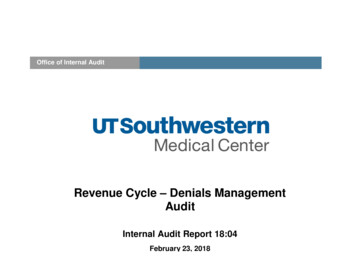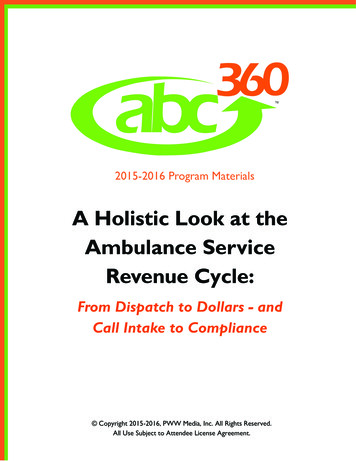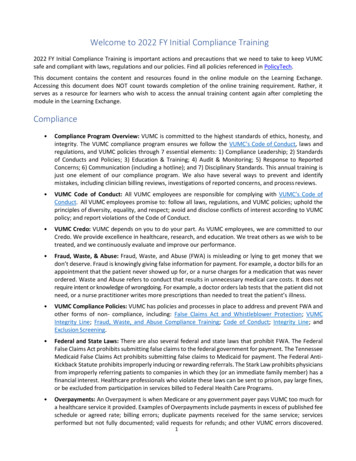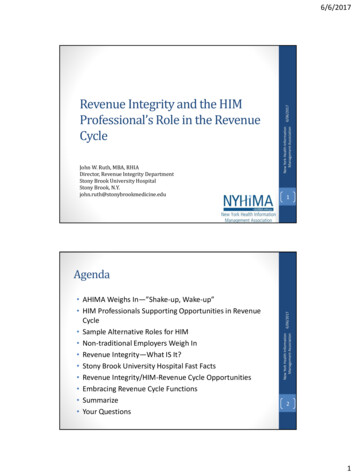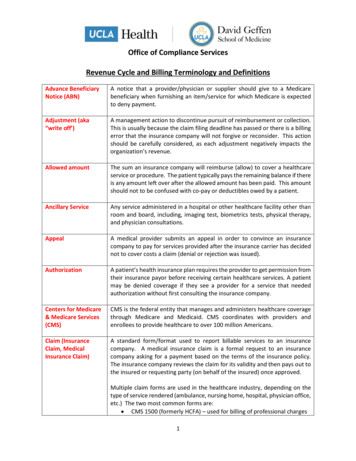
Transcription
Office of Compliance ServicesRevenue Cycle and Billing Terminology and DefinitionsAdvance BeneficiaryNotice (ABN)A notice that a provider/physician or supplier should give to a Medicarebeneficiary when furnishing an item/service for which Medicare is expectedto deny payment.Adjustment (aka“write off’)A management action to discontinue pursuit of reimbursement or collection.This is usually because the claim filing deadline has passed or there is a billingerror that the insurance company will not forgive or reconsider. This actionshould be carefully considered, as each adjustment negatively impacts theorganization’s revenue.Allowed amountThe sum an insurance company will reimburse (allow) to cover a healthcareservice or procedure. The patient typically pays the remaining balance if thereis any amount left over after the allowed amount has been paid. This amountshould not to be confused with co-pay or deductibles owed by a patient.Ancillary ServiceAny service administered in a hospital or other healthcare facility other thanroom and board, including, imaging test, biometrics tests, physical therapy,and physician consultations.AppealA medical provider submits an appeal in order to convince an insurancecompany to pay for services provided after the insurance carrier has decidednot to cover costs a claim (denial or rejection was issued).AuthorizationA patient’s health insurance plan requires the provider to get permission fromtheir insurance payor before receiving certain healthcare services. A patientmay be denied coverage if they see a provider for a service that neededauthorization without first consulting the insurance company.Centers for Medicare& Medicare Services(CMS)CMS is the federal entity that manages and administers healthcare coveragethrough Medicare and Medicaid. CMS coordinates with providers andenrollees to provide healthcare to over 100 million Americans.Claim (InsuranceClaim, MedicalInsurance Claim)A standard form/format used to report billable services to an insurancecompany. A medical insurance claim is a formal request to an insurancecompany asking for a payment based on the terms of the insurance policy.The insurance company reviews the claim for its validity and then pays out tothe insured or requesting party (on behalf of the insured) once approved.Multiple claim forms are used in the healthcare industry, depending on thetype of service rendered (ambulance, nursing home, hospital, physician office,etc.) The two most common forms are: CMS 1500 (formerly HCFA) – used for billing of professional charges1
Office of Compliance Services Claim HoldCoinsuranceCMS 1450 (also called UB04) – used for hospital/facility chargesThe process of holding a billing claim for a period of time for internal review.Typically, this is done to conduct a quality assurance check prior to submittingto the insurance company.An amount, typically a percentage, contractually agreed-upon between theinsurance company and the guarantor that will be paid by the insurancecompany after the guarantor has met other payment obligations.Example: 15,000 charge minus 10,000 deductible (paid by guarantor) equals 5,000 balance minus 20% coinsurance ( 1,000 due from guarantor) equals 4,000 billable to insurance companyContractualadjustmentThe mutually agreed upon difference between the charge amount on a claimand the allowed amount applied by the insurance company. A bindingagreement between a provider, patient, and insurance company wherein theprovider agrees to portions of charges that it will adjust (“write off”) on behalfof the patient. Contractual adjustments may occur when there is adiscrepancy between what a provider charges for healthcare services andwhat an insurance company has decided to pay for that service.Coordination ofBenefits (COB)COB occurs when a patient is covered by more than one insurance plan. In thissituation, one insurance company will become the primary carrier, all othercompanies will be considered secondary, and tertiary carriers that may covercosts left after the primary carrier has paid.Copayment (co-pay)A patient’s co-pay is the amount that must be paid to a provider (hospital orphysician) before they receive any treatment or services. Co-pays areseparate from a deductible, and will vary depending on a patient’s insuranceplan.Example: 300 charge minus 50 co-payment equals 250 billable to insurance companyCurrent ProceduralTerminology (CPT)CodesCPT Codes represent treatments and procedures performed by a physician ina 5-digit format. Physicians and their coding teams determine the appropriateCPT, HCPCS, ICD-10, and other codes that explain the services and diagnosesprovided in each patient encounter. The CPT, HCPCS, ICD-10, and other codesand modifiers are reported on insurance claims to justify reimbursement forthose services.2
Office of Compliance ServicesCPT is the classification system jointly developed by the American MedicalAssociation (AMA) and CMS.DeductibleThe amount a guarantor must pay before an insurance carrier starts theirhealthcare coverage. Deductibles range in price according to terms set in aperson’s health plan.Example: 15,000 charge minus 10,000 deductible (paid by guarantor) equals 5,000 billable to insurance companyDepartment of Healthand Human Services(HHS)The mission of the U.S. Department of Health & Human Services (HHS) toenhance and protect the health and well-being of all Americans. Thedepartment fulfills that mission by providing for effective health and humanservices and fostering advances in medicine, public health, and social services.The HHS has 11 operating divisions, including the Centers for Medicare &Medicaid Services (CMS), the Food and Drug Administration (FDA), and theNational Institutes of Health (NIH).DependentThe individuals eligible for coverage under a particular guarantor. Example:In the case of a single mother with coverage, the mother would be theguarantor, and the children would be dependents.Group NameThe name of the group, insurance carrier, or insurance plan that covers apatient.Group NumberA number given to a patient by their insurance carrier that identifies the groupor plan under which they are covered.GuarantorThe party paying for an insurance plan who is not the patient. Parents, forexample, would be the guarantors for their children’s health insurance.Healthcare CommonProcedure CodingSystem (HCPCS)CodesHCPCS codes represent produces, supplies, and services used in the course ofpatient treatment. Physicians and their coding teams determine theappropriate CPT, HCPCS, ICD-10, and other codes that explain the services anddiagnoses provided in each patient encounter. The CPT, HCPCS, ICD-10, andother codes and modifiers are reported on insurance claims to justifyreimbursement for those services.HCPCS is a classification system jointly developed by the American MedicalAssociation (AMA) and CMS. It is a standardized coding system used primarilyto identify products, supplies, and services not included in the CPT codes, such3
Office of Compliance Servicesas ambulance services and durable medical equipment, prosthetics, orthotics,and supplies (DMEPOS) when used outside a physician's office.Health MaintenanceOrganization (HMO)An HMO is a type of health insurance plan that usually limits coverage to carefrom doctors who work for or contract with the HMO. It generally will notcover out-of-network care except in an emergency. An HMO may require youto live or work in its service area to be eligible for coverage.InpatientHealthcare treatment that requires an overnight hospital stay. Billingprocesses and reimbursements differ significantly between inpatient andoutpatient settings.InternationalClassification ofDisease (ICD)-10CodesICD codes represent diagnoses made by physicians regarding a patient’shealth. Physicians and their coding teams determine the appropriate CPT,HCPCS, ICD-10, and other codes that explain the services and diagnosesprovided in each patient encounter. The CPT, HCPCS, ICD-10, and other codesand modifiers are reported on insurance claims to justify reimbursement forthose services.ICD-10 is the 10th revision of the International Statistical Classification ofDiseases and Related Health Problems (ICD), a medical classification list by theWorld Health Organization (WHO). It contains codes for diseases, signs andsymptoms, abnormal findings, complaints, social circumstances, and externalcauses of injury or diseases. ICD-10 codes are the updated international set ofcodes based on the preceding ICD-9 codes.Local CoverageDetermination (LCD)An LCD is a decision by a Medicare Administrative Contractor (MAC) whetherto cover a particular service on a MAC-wide basis.Managed Care PlanA health insurance plan whereby patients can only receive coverage if theysee providers who operate in the insurance company’s network.Maximum Out ofPocketThe maximum amount a patient is required to pay. After a patient reachestheir maximum out-of-pocket, their healthcare costs should be covered bytheir plan.MedicareAdministrativeContractor (MAC)A MAC (previously known as Fiscal Intermediary) is contracted with CMS toserve as a clearinghouse to process Medicare claims, as CMS itself does notprocess claims. Different MACs operate in different parts of the country, andeach may manage different claim type combinations. Providers, facilities, andother billing entities in the states within each MAC’s jurisdiction submit theirclaims to that MAC for reimbursement. Each MAC must follow standard CMSrules for reimbursement and claims processing (NCD), and each can makelocal decisions (LCD) when CMS rules are not clear. The Medicare(Previously known asFiscal Intermediary)4
Office of Compliance ServicesAdministrative contractor for Northern and Southern California is Noridian,LLC.Medicaid (MedicalAssistance, Medi-Cal)Medicaid is a joint federal and state assistance program started in 1965 toprovide health insurance to lower-income persons. Both state and federalgovernments fund Medicaid programs, and each state is responsible formanaging its own version of Medicaid within the minimum requirementsestablished by federal law. Significant program differences exist from state tostate. The state of California refers to its program as Medi-Cal.Medical NecessityThis term refers to healthcare services or treatments that a patient requiresto treat a serious medical condition or illness. This does not include cosmeticor investigative services.Medical RecordNumber (MRN)A unique number attributed to a person’s medical record so it can bedifferentiated from other medical records.MedicareMedicare is a health insurance program under the Social SecurityAdministration’s Health Care Financing Administration that consists of 2 parts:Medicare Part A and Medicare Part B.Medicare Part A – Hospital Insurance. This is a hospital insurance (includingskilled nursing facility and home health care) for almost everyone over the ageof 65, the permanently disabled, and those with chronic renal failure.Coverage under Part A Medicare is automatic.Medicare Part B – Medical Insurance. Part B covers most medically necessarydoctors' services, preventive care, durable medical equipment, hospitaloutpatient services, laboratory tests, x-rays, mental health care, and somehome health and ambulance services. The patient pays a monthly premiumfor this coverage.Medicare Part C – Medicare Advantage. Medicare-approved plans that allowprivate health insurance companies to offer Medicare benefits to Part A andPart B enrollees. Medicare Advantage plans are typically offered in HMO andPPO models and provide additional benefits.Coverage rules andreimbursements vary by plan.Medicare Part D - Outpatient Prescription Drug Insurance. Part D is providedonly through private insurance companies that have contracts with thegovernment—it is never provided directly by the government (like OriginalMedicare).5
Office of Compliance ServicesMedi-MediSome people qualify for both Medicare and Medicaid and are called “dualeligibles.” This is also referred to as “Medi-Medi.”For services that both Medicare and Medi-Cal cover (such as doctor's visits,lab tests, and hospital care) Medicare pays first, and Medi-Cal pays second.Medi-Cal will pick up some costs not covered by Medicare, such as copayments and coinsurance amounts. Medi-Cal pays for your Medicare copayments and deductibles.Medicare SecondaryPayerThe insurance company that covers any remaining expenses after Medicarehas paid for a patient’s coverage.ModifierModifiers are additions to CPT codes that explain alterations andmodifications to an otherwise routine treatment, exam, or service.National CoverageDetermination (NCD)An NCD is a United States' nationwide determination of whether Medicarewill pay for an item or service.Network ProviderA medical provider within a health insurance company’s network that hascontracted with the company to provide discounted services to a patientcovered under the company’s plan.National ProviderIdentifier (NPI)NumberA unique 10-digit number ascribed to every healthcare provider in the U.S. asmandated by HIPAA. The NPI number is required on every insurance claim.Office of InspectorGeneral (OIG)The organization responsible for establishing guidelines and investigatingfraud and misinformation within the healthcare industry. The OIG is part ofthe Department of Health and Human Services.Out-of-NetworkOut-of-network refers to providers outside of an established network ofproviders who contract with an insurance company to offer patientshealthcare at a discounted rate. People who go to out-of-network providerstypically have to pay more money to receive care.OutpatientHealthcare treatment that does not require an overnight hospital stay,including a routine visit to a primary care doctor or a non-invasive surgery.Billing processes and reimbursements differ significantly between inpatientand outpatient settings.Patient ResponsibilityThis refers to the amount a patient owes a provider after an insurancecompany pays for their portion of the medical expenses.6
Office of Compliance ServicesPatient StatementA printed bill that displays the details such as the amount that each patienthas to pay, service dates, charges, and transaction descriptions along with thepatient's demographic details is called as patient statement.Primary CarePhysician (PCP)The physician who provides the basic healthcare services for a patient andrecommends additional care for more serious treatments as necessary.Point of Service PlansA plan whereby patients with HMO membership may receive care at nonHMO providers in exchange for a referral and paying a higher deductible.Pre-authorization/Pre-certificationSome insurance plans require that a patient receive pre-authorization or precertification from the insurance company prior to receiving certain medicalservices to make sure the company will cover expenses associated with thoseservices. The insurance company issues a particular alpha-numeric code whenapproved, which must be included on the claim form.Preferred ProviderOrganization (PPO)A PPO is a managed care organization of providers who contract with aninsurance company to provide services to enrolled patients. It is generallymore flexible than an HMO.ReferralA provider recommends a different provider to a patient to receive specializedtreatment. Depending on the terms of their insurance coverage, patients maybe required to obtain a referral prior to seeing a specialist or other physician,and the refusal to obtain a referral may result in the subsequent specialistservice being ineligible for insurance coverage.Remittance Advice(R/A)The R/A is also known as the Explanation of Benefits (EOB), which is thedocument attached to a processed claim that explains the informationregarding coverage and payments on a claim.Responsible Party/GuarantorThe person who pays for a patient’s medical expenses, also known as theguarantor. The guarantor may be the patient, or the person responsible fordependent coverage. Example: In the case of a single mother with coverage,the mother would be the guarantor, and the children would be dependents.Self-PayPayment made by the patient for healthcare at the time they receive it at aprovider’s facilities.SubscriberThe individual covered under a group policy. For instance, an employee of acompany with a group health policy would be one of many subscribers on thatpolicy.SupplementalInsuranceSupplemental insurance can be a secondary policy or another insurancecompany that covers a patient’s healthcare costs after receiving coverage7
Office of Compliance Servicesfrom their primary insurance. Supplemental insurance policies typically helppatients cover expensive deductibles and co-pays.TreatmentAuthorizationRequest (TAR)A unique number the insurance company assigns the provider for billingpurposes. A provider must receive the insurance company’s TAR numberbefore administering healthcare to a patient covered by the company.Tax IdentificationNumber (TIN)A unique number a patient or a company may have to produce for billingpurposes in order to receive healthcare from a provider. The TIN is also knownas the employment identification number (EIN).TRICARETRICARE is the federal health insurance plan for active service members,retired service members, and their families, in addition to survivors of servicemembers. TRICARE was previously known as CHAMPUS.Terminology and Definitions specific to Clinical Research Operations & BillingAnti-kickback StatuteA criminal statute that prohibits the exchange (or offer to exchange), of anything ofvalue, in an effort to induce (or reward) the referral of federal health care programbusiness.Billing DesignationIdentification within the coverage analysis billing grid of how an individual patientcare cost is covered within a clinical research study, and the party responsible forcovering the cost of the item. Billing designations may routine cost (RC), standard ofcare (SOC), Sponsor paid (S), or non-billable (NB).Billable EventPatient care items/services such as clinic visits, procedures, radiology, labs, etc. thatmay generate a charge in the healthcare billing system. These events are typicallyassociated with a CPT and/or HCPCS code.Clinical Trial Agreement(CTA)A Clinical Trial Agreement (CTA) is a legally binding agreement that manages therelationship between the sponsor that may be providing the study drug or device,the financial support and /or proprietary information and the institution that maybe providing data and/or results, publication, input into further intellectualproperty.Condition Code 30Identifies non-research services (or routine costs) provided to all patients, includingmanaged care enrollees, enrolled in a Qualified Clinical Trial, and is included oninstitutional claims.Contract ResearchOrganization (CRO)A contract research organization (CRO) is an organization that provides support tothe pharmaceutical, biotechnology, and medical device industries in the form of8
Office of Compliance Servicesresearch services outsourced on a contract basis. A CRO’s services may includebiopharmaceutical development, biologic assay development, commercialization,pre-clinical research, clinical research, clinical trials management, andpharmacovigilance. CROs provide a more affordable outlet for companies to pursuenew medicines, and a cost-effective solution to develop drugs for even nichemarkets.Coverage Analysis (akaMedicare CoverageAnalysis)This is a process that:a) determines if the clinical study is a Qualifying ClinicalTrial, andb) ensures costs for clinical study items/services/procedures are designated asresearch costs or routine costs, to ensure proper billing of such costs to either theclinical study, Sponsor or a third party payor.Coverage with EvidenceDevelopment (CED)A CMS program that provides conditional coverage for new technology andprocedures while it collects information from providers regarding effectiveness. Itrequires participants to enroll in a clinical trial or registry, and the correspondingNational Clinical Trial (NCT) # must be included on the claim with the appropriatedesignated CPT and ICD codes.Diagnosis code Z00.6(formerly known as V70.7)Identifies an encounter for examination for normal comparison and control inclinical research program.For institutional claims, ICD-10 diagnosis code Z00.6 and condition code 30 are usedto denote services provided on a clinical study.For professional claims, the ICD-10 diagnosis code Z00.6 (together with additionalspecial billing rules) is used to identify items/services on a clinical study.Expanded Access protocol(aka Compassionate Care)Expanded access, also known as "compassionate use," is the use outside of a clinicaltrial, of an investigational medical product (i.e., one that has not been approved byFDA), for treatment of a patient when patient’s enrollment in a clinical trial is notpossible (e.g., a patient is not eligible for any ongoing clinical trials, or there are noongoing clinical trials). In this case, the patient may be able to receive the product,when appropriate through expanded access.Double Billing (DoubleDipping)Double billing occurs when the same item/service is paid for by two differentsources (e.g. patient’s insurance and study sponsor).False Claims Act (FCA)Federal law that imposes liability on persons and companies who defraudgovernmental programs. It is the federal Government's primary litigation tool incombating fraud against the Government. This legislation prohibits anyone fromknowingly submitting or causing to be submitted a false or fraudulent claim.IndicationDescription of use of an FDA approved drug or device in the treatment, preventionor diagnosis of a recognized disease or condition.9
Office of Compliance ServicesInvestigational New Drug(IND) ApplicationAn Investigational New Drug Application (IND) is a request for authorization fromthe FDA to administer an investigational drug or biological product to humans.Such authorization must be obtained prior to interstate shipment andadministration of any new drug or biological product that is not the subject of anapproved New Drug Application or Biologics/Product License Application.Investigational DeviceExemption (IDE)An investigational device exemption (IDE) allows the investigational device to beused in a clinical study in order to collect safety and effectiveness data. Clinicalstudies are most often conducted to support a Pre-market Approval application.Investigational use also includes clinical evaluation of certain modifications or newintended uses of legally marketed devices. All clinical evaluations of investigationaldevices, unless exempt, must have an approved IDE before the clinical study isinitiated.Medically NecessaryHealth care services or supplies needed to prevent, diagnose, or treat an illness,injury, condition, disease, or its symptoms and that meets accepted standards ofmedicine.Medicare Benefit CategoryMedicare coverage is limited to items/services that are considered "reasonable andnecessary" for the diagnosis or treatment of an illness or injury, and within the scopeof a Medicare benefit category (i.e. the item/services is not excluded from Medicarecoverage).National Clinical Trial (NCT)NumberAn 8-digit number, assigned by the ClinicalTrials.gov website, to each clinical trialand registry. All research-related charges on a claim must include the pertinentstudy NCT#, and clinical trials must be publicly registered on the website prior toprofessional publication.Non-Billable EventAn item/service that is provided at no cost and/or does not generate a charge inhealthcare billing system. Examples include labs sent to central lab for processing,or an investigational product that is provided free.Off Label use of drug ordeviceAn “off-label” use is one the FDA has not expressly approved, i.e. change in dosing,patient population, purpose.The Food Drug and Cosmetic Act (“FDCA”) prohibits manufacturer from marketingor promoting drug or device for off-label use. 21 U.S.C. § 331(a), (d)Office of Inspector General(OIG)The organization responsible for establishing guidelines and investigating fraud andmisinformation within the healthcare industry. The OIG is part of the Department ofHealth and Human Services.10
Office of Compliance ServicesOpen Payments – Centersfor Medicare & MedicaidServices (aka Sunshine Act)QO modifierOpen Payments is a federal program, required by the Affordable Care Act, thatcollects information about the payments drug and device companies make tophysicians and teaching hospitals for things like travel, research, gifts, speaking fees,and meals. It also includes ownership interests that physicians or their immediatefamily members have in these companies.Identifies an investigational clinical item/service provided in a clinical research studythat is in an approved clinical research study.An investigational clinical item/service is defined as an item/service that is beinginvestigated as an objective within the clinical research study (this item/service thatmay be approved, unapproved, or otherwise covered, or not covered underMedicare).Q1 modifierRoutine clinical service provided in a clinical research study that is in an approvedclinical research study.A routine clinical services are defined as those items and services that are coveredfor Medicare beneficiaries outside of the clinical research study; are used for thedirect patient management within the study; and, do not meet the definition ofinvestigational clinical services. Routine clinical services may include items orservices required solely for the provision of the investigational clinical services (e.g.,administration of a chemotherapeutic agent); clinically appropriate monitoring,whether or not required by the investigational clinical service (e.g., blood tests tomeasure tumor markers); and items or services required for the prevention,diagnosis, or treatment of research related adverse events (e.g., blood levels ofvarious parameters to measure kidney function).Qualifying Clinical Trial(QCT)A study that meets Medicare’s criteria under the National Coverage Determination(NCD 310.1) “Routine Costs in Clinical Trials”.Research “only”Items and/or services that are not an allowable expense to the patient, notconsidered routine, or covered and paid by the study sponsor.Routine costsThe following items and/or services will be covered as a “routine cost” of the studyso long as it is not agreed to be paid or paid by the sponsor and it is not promisedfree to the subject in the informed consent:1.Items and services that are otherwise generally available (e.g., conventionalcare) to Medicare beneficiaries (i.e., there exists a benefit category, it is notstatutorily excluded, and there is not a national non-coverage decision, etc.);2.Items or services required solely for the provision of the investigational itemor service (e.g., administration of a non-covered chemotherapeutic agent), theclinically appropriate monitoring of the effects of the item or service, or theprevention of complications; and11
Office of Compliance Services3.Items or services needed for reasonable and necessary care arising from theprovision of an investigational item or service in particular, for the diagnosis ortreatment of complications4.All other Medicare rules applyStudy SponsorAn individual, institution, company or organization (for example, a contract researchorganization) that takes the responsibility to initiate, manage or finance the clinicaltrial, but does not actually conduct the investigation.The Revenue Cycle Management and tionand DenialsManagementCoding andBillingInsuranceClaimsProcess12
Office of Compliance ServicesIntroductionThe term “Revenue Cycle” implies that billing is a cyclical process. In reality, the healthcare billing process islinear, much like billing in other industries.Specifically, there are 4 major components to the Revenue Cycle process.The customer/client/patient:1) Identifies a need for service and contacts a service provider to arrange for service delivery2) Receives the service, and perhaps makes a deposit or installment payment3) Receives a billing statement4) Pays the bill, with no outstanding balance or billing issuesThe healthcare revenue cycle process is more complex than for other industries due to the multiple partiesinvolved in reimbursement. Different governmental agencies, insurance companies, research sponsors, andothers may be contractually responsible for the payment of medical services, and each potential payor mustfollow established regulations and/or self-imposed additional billing rules.There are several potential leakage/failure points in the revenue cycle that include, but are not limited to: No referral Registration, coding or billing errors Unverified insurance coverage Underpaid claims Denied appealsRevenue Cycle Components1) The customer/client/patient identifies a need for service and contacts a service provider toarrange for service deliveryWhen a patient calls for appointment, an appropriate and sufficient time slot must be scheduled anddesignated. If it is the patient’s first visit, information must be collected by the front office to prepare for thepatient visit. This includes basic information about the patient, including name, address, date of birth, andreason for visit. The front office must also collect insurance information from the patient, including the nameof the insurance provider, and the patient’s policy number. Setting up and updating medical files for the patientexpedites the billing process and makes patient check-in easier and more efficient.2) The customer/client/patient receives the service, and perhaps makes a deposit or installmentpaymentScheduling:A patient may arrive in a physician office, hospital department, ambulatory surgery center, emergency roo
Claim, Medical Insurance Claim) A standard form/format used to report billable services to an insurance company. A medical insurance claim is a formal request to an insurance company asking for a payment based on the terms of the insurance policy. The insurance company reviews the claim for its validity and then pays out to





